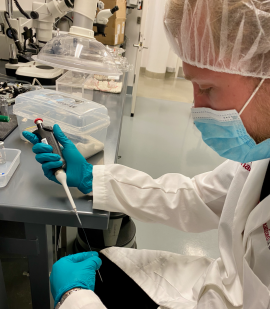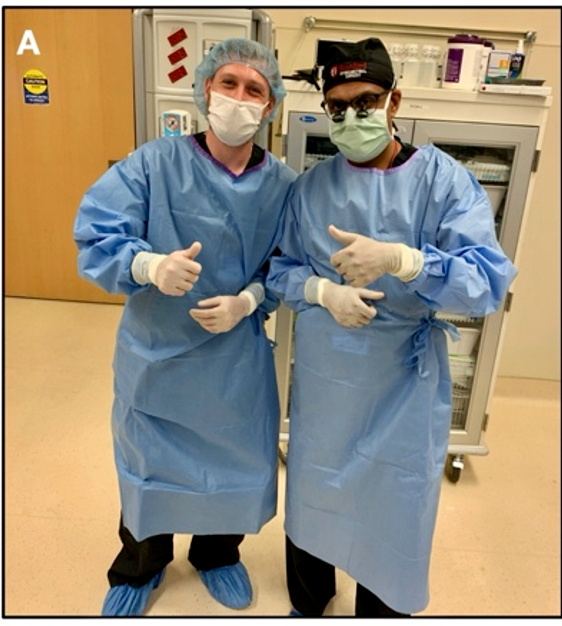Palo Alto, CA — Training medical students from around the world is an important mission of Dr. Mahajan’s lab at Stanford University. Supported by the São Paulo Research Foundation (FAPESP), Luis Sabage, a 5th year medical student from The University of São Paulo, Camus of Bauru, Brazil, joined the lab for three months to immerse himself in basic and translational vision research. His educational activities at Stanford exposed him to novel technologies and resources to treat patients that he hopes to eventually use to improve eye health in his own country.
Vinit Mahajan M.D., Ph.D., ophthalmology professor and vice chair of research, said, “We enjoy bringing in medical students, but it is a challenge for them to accomplish significant research in such a short time. Luis exceeded all expectations and raised the bar for future students.”

Under the guidance of lab postdoctoral fellows Young Joo Sun Ph.D. and Julian Wolf M.D., Luis trained in a variety of basic and advanced laboratory techniques. Some of these techniques included biochemical enzyme assays for human and pig vitreous, confocal microscopy, histology analysis, cell counting, and application of cellular trans-well systems.
Julian said, “Luis was quick to pick up various surgical and clinical procedures, including porcine eye dissection, mouse optical coherence tomography and electroretinography, mice anesthesia, mice intravitreal and subretinal injections, and mice enucleation. Learning these microsurgical procedures will translate directly into humans.”
Young Joo added, “Luis came to lab with his own data from Brazil where he had studied SARS-CoV-2 infection in tears from COVID patients. We worked with Luis on data analysis and writing his manuscript.” Luis presented the research findings in a poster session at the 3rd Annual International Stanford Center for Optic Disc Drusen Conference.
Mahajan said, “Luis was able to make significat scientific contributions in a short period of time. He attended our scientific writing course and authored and co-authored two peer-reviewed manuscripts that he submitted for publication. One paper on human vitreous research methods was recently accepted.”
Other hands-on activities included making microneedles for animal eye injections, surgical teaching video filming and editing, designing and giving lab meeting and patient case presentations, linking molecules and molecular pathways to eye disease in “omics data sets,” statistical analyses, application of scientific software, and human eye tissue biobanking,
Luis said, “Everyone was so supportive in the lab. I learned and accomplished more than I expected. Seeing how well integrated the lab was with the clinic and operating room was a real inspiration.”

When he wasn’t in the lab, Luis shadowed Dr. Mahajan in his retina clinic and operating room at the Byers Eye Institute. He spent significant time with ocular oncologist Prithvi Mruthyunjaya M.D. supporting his cancer clinical trials.
The rich didactics at Stanford presented additional opportunities. Luis participated in several surgical wet labs with the Stanford ophthalmology residents. In the classroom microscope wet labs, he performed cataract surgery in pig eyes. He attended resident lectures, retinal imaging conferences, ophthalmology grand rounds, and the weekly eye pathology case reviews. In the summer Bay Area Ophthalmology Course, he learned about current research in optics, cataracts, and ocular oncology. He also took advantage of the department’s excellent Friday seminar series, hearing a Cell Press editor-in-chief speak about the behind-the-scenes choices editor’s make. He also attended the lecture of Dr. Francis Arnold, the fifth woman to win a Nobel prize in chemistry.
Luis said, “Aside from all my studies, I found time to make good friends by attending lab socials, visiting the Museum of the Eye in San Francisco, and experiencing American culture at baseball games - eating hot dogs and enjoying a beautiful view of the San Francisco Bay. I really enjoyed meeting people from around the world. My experience in the Mahajan lab was incredible.”

